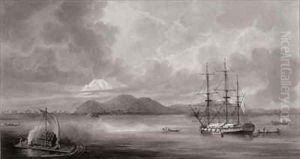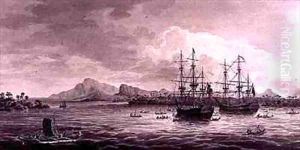Fernando Brambila Paintings
Fernando Brambila was a Spanish painter, engraver, and lithographer born on April 14, 1763, in Forno di Canale (now part of Italy, but then under the domain of the Republic of Venice). His artistic journey began in Italy, where he trained and worked until he moved to Spain. Brambila is particularly known for his landscape paintings and architectural views, which were a popular genre during the Enlightenment as they reflected society's growing interest in science, exploration, and empirical observation.
In 1789, Brambila relocated to Madrid, and by 1791, he was appointed as a chamber painter to Charles IV of Spain. This role included the task of documenting royal sites and possessions, a common practice of the time, which served both as a record and as a demonstration of the monarch’s wealth and power. His work during this period often depicted landscapes, palaces, and other significant sites in a detailed and accurate manner.
Brambila's most notable project was his involvement in the creation of the collection 'Views of the Royal Sites and of the City of Madrid', a series of prints produced at the behest of the Spanish crown. This project was part of a larger endeavor known as 'The Spanish Royal Sites', which aimed to compile a comprehensive visual record of Spain's palatial architecture and gardens. His contributions to this project are considered some of the finest examples of his work, showcasing his meticulous attention to detail and his ability to capture the grandeur of his subjects.
One of the highlights of Brambila's career was his participation in the Malaspina Expedition from 1789 to 1794. This scientific and political voyage, led by the Italian explorer Alessandro Malaspina, was commissioned by the Spanish government with the aim of furthering geographical, botanical, and anthropological knowledge. Brambila was responsible for recording the landscapes and peoples encountered during the journey. The resulting artworks provided valuable insights into the territories Spain was interested in during the late 18th century.
Despite the importance of these works, many of Brambila's contributions have been overshadowed by the more famous artists of his time. His style is characterized by a precise and somewhat austere realism, which was typical of the neoclassical aesthetic prevalent during his lifetime.
Fernando Brambila passed away on February 5, 1834, in Madrid. Though he may not be as widely recognized as some of his contemporaries, his works remain an important part of Spanish art history and continue to be studied for their historical and artistic value, reflecting the Enlightenment's drive for knowledge and documentation.

